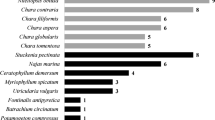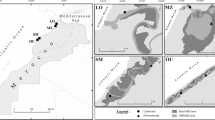Abstract
The relationship between hydrological conditions and riparian helophyte vegetation was studied in two freshwater estuaries that differed in tidal regulation in order to assess the effects of large-scale hydrological regulation on the fringe vegetation. Vegetation and environmental variables were sampled for 206 sites in the Rhine-Meuse estuary (146 sites) and the IJsselmeer region (60 sites) in the Netherlands. These samples were classified into 10 vegetation types, all of which were dominated by tall helophytes. The most common vegetation types were dominated byPhragmites australis andTypha angustifolia, which formed both monospecific stands and mixtures. Tall Cyperaceae dominated three vegetation types (dominated individually bySchoenoplectus lacustris, Bolboschoenus maritimus, andSchoenoplectus tabernaemontani).Acorus calamus. Principal components analysis of the species composition of vegetation fringing open-water areas and associated environmental data revealed complex gradients incorporating differences in water depth, water-level fluctuation, were exposure, and sedimentation and/or erosion. The composition of the helophyte belts varied among the areas as the result of the differing times at which regulation occurred. Based on historical data, hydrological regulation of the estuaries has resulted in deterioration of intertidalSchoenoplectus andBolboschoenus stands, due to erosion and predation.P. australis stands have been invaded by terrestrial plant species or have been replaced byT. angustifolia. A scheme is presented of helophyte vegetation development under the influence of changes in the hydrological regime.
Similar content being viewed by others
Literature Cited
Boutin, C. andP. A. Keddy. 1993. A functional classification of wetland plants.Journal of Vegetation Science 4:591–600.
Breen, C. M., K. H. Rogers, andP. J. Ashton. 1988. Vegetation processes in swamps and flooded plains, p. 223–247.In J. J. Symoens (ed.), Vegetation of Inland Waters. Kluwer, Dordrecht, The Netherlands.
Clevering, O. A. 1995. Life-history characteristics ofScirpus lacustris andScirpus maritimus, with special reference to the restoration of these species in former tidal areas. Thesis, University of Nijmegen, Nijmegen, The Netherlands.
Conchou, O. andE. Fustec. 1988. Influence of hydrological fluctuations on the growth and nutrient dynamics ofPhalaris arundinacea L. in a riparian environment.Plant and Soil 112: 53–60.
Coops, H. andG. Van der Velde. 1996. Impact of hydrodynamic changes on the zonation of helophytes.Netherlands Journal of Aquatic Ecology 30:165–173.
Day, R. T., P. A. Keddy, J. McNeill, andT. Carleton. 1988. Fertility and disturbance gradients: A summary model for riverine marsh vegetation.Ecology 69:1044–1054.
De Boois, H. 1982. Veranderingen in het milieu en de vegetatie in de Biesbosch door de afsluiting van het Haringvliet. Thesis, Wageningen Agricultural University, Wageningen, The Netherlands.
Ellenberg, H. 1963. Vegetation Mitteleuropas mit den Alpen. E. Ulmer Verlag, Stuttgart, Germany.
Ferguson, H. A. andW. J. Wolff. 1983. The Haringvliet-project: The stagnant freshwater lake.Water Science and Technology 16:11–26.
Haslam, S. M. 1971. Community regulation inPhragmites communis Trin.: II. Mixed stands.Journal of Ecology 59:75–88.
Hill, M. O. 1979. TWINSPAN—A FORTRAN Program for Arranging Multivariate Data in an Ordered Two-way table by Classification of Individuals and Attributes. Cornell University, Ithaca, New York.
Johnson, W. C., T. L. Sharik, R. A. Mayes, andE. P. Smith. 1987. Nature and cause of zonation discreteness around prairie glacial marshes.Canadian Journal of Botany 65:1622–1632.
Jongman, R. H. G., C. J. F. ter Braak, andF. R. Van Tongeren. 1987. Data Analysis in Community and Landscape Ecology. Pudoc, Wageningen, The Netherlands.
Klopatek, J. M. 1978. Nutrient dynamics of freshwater riverine marshes and the role of emergent macrophytes, p. 195–216.In R. E. Good, D. F. Whigham, and R. L. Simpson (eds.), Freshwater Wetlands: Ecological Processes and Management. Academic Press, New York.
Klosowski, S. 1988. Ökotogische Amplitude und Zeigerwert der häufigeren Röhricht-gesellschaften im nordöstlichen Teil Polens.Limnologica 19:109–125.
Kopecky, K. 1966. Ökologische Hauptunterschiede zwischen Röhrichtgesellschaften fliessender und stehender Binnengewässer Mitteleuropas.Folia Geobotanica et Phytotaxonomica 1: 193–242.
Kuijpers, J. W. M. 1994. Ecological restoration of the Rhine/Maas estuary.Water Science and Technology 31:187–195.
Mitsch, W. J. andJ. G. Gosselink. 1993. Wetlands, 2nd edition. Van Nostrand Reinhold, New York.
Nilsson, C., A. Ekblad, M. Gardfjell, andB. Carlberg. 1991. Long-term effects of river regulation on river margin vegetation.Journal of Applied Ecology 28:963–987.
Odum, W. E. andJ. K. Hoover. 1988. A comparison of vascular plant communities in tidal freshwater and saltwater marshes, p. 526–534.In D. D. Hook, W. H. McKee Jr., H. K. Smith, J. Gregory, V. G. Burrell, Jr., M. R. DeVoe, R. E. Sojka, S. Gilbert, R. Banks, L. H. Stolzy, C. Brooks, T. D. Matthews, and T. H. Shear (eds.), The Ecology and Management of Wetlands. Croom Helm, London, United Kingdom.
Phillips, J. D. 1987. Shoreline processes and establishment ofPhragmites australis in a coastal plain estuary.Vegetatio 71:139–144.
Schaminée, J. H. J., A. H. F. Stortelder, andV. Westhoff. 1995. De Vegetatie van Nederland I. Inleiding tot de Plantensociologie—Grondslagen, Methoden en Toepassingen. Opulus Press, Uppsala, Sweden.
Smit, H., G. Van der Velde, R. Smits, andH. Coops. 1997. Ecosystem responses in the Rhine-Meuse delta during two decades after enclosure and steps toward estuary restoration.Estuaries 20:504–520.
Spence, D. H. N. 1982. The zonation of plants in freshwater lakes.Advances in Ecological Research 12:37–125.
Ter Braak, C. J. F. 1991. CANOCO—A FORTRAN Program for Canonical Community Ordination by (Partial) (Detrended) (Canonical) Correspondence Analysis, Principal Components Analysis and Redundancy Analysis (Version 3.1). TNO Institute of Applied Computer, Science, Wageningen, The Netherlands.
Van der Meiden, R. 1996. Heukels’ Flora van Nederland, 22nd edition. Wolters-Noordhoff, Groningen, The Netherlands.
Van der Valk, A. G. 1981. Succession in wetlands: A Gleasonian approach.Ecology 62:688–696.
White, D. A. 1993. Vascular plant community development on mudflats in the Mississippi River delta, Louisiana, USA.Aquatic Botany 45:171–194.
Wieringa, J. andP. J. Rijkoort. 1983. Windklimaat van Nederland. KNMI, De Bilt, The Netherlands.
Wolf, A. 1988. Röhrichte und Rieder des holsteinischen Elbufers untershalb Hamburgs,Schriftreihe der Naturwissenschaftlichen Vereinigung Schleswig-Holsteins 58:55–68.
Zonneveld, I. S. 1959. De Brabantse Biesbosch. A study of soil and vegetation of a fresh water tidal delta. Verslagen Landbouwkundige Onderzoekingen No. 65.20, Wageningen, The Netherlands.
Author information
Authors and Affiliations
Corresponding author
Rights and permissions
About this article
Cite this article
Coops, H., Geilen, N. & van der Velde, G. Helophyte zonation in two regulated estuarine areas in the Netherlands: Vegetation analysis and relationships with hydrological factors. Estuaries 22, 657–668 (1999). https://doi.org/10.2307/1353053
Received:
Accepted:
Issue Date:
DOI: https://doi.org/10.2307/1353053




